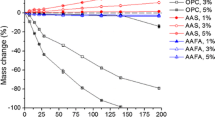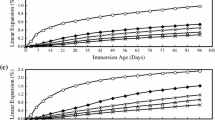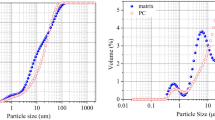Abstract
This paper describes a study carried out to examine the sulfate resistance of a wide range of pulverized-fuel ash (PFA) grouts. A number of material variables were considered reflecting those used in practice, including PFA content, and cement and PFA material characteristics (between sources). Several exposure environment conditions were also tested. It was found that under Class 5 sulfate exposure conditions, as classified in BRE Digest 363 (upper limit of Class XA3 to prEN 206), expansion was reduced with increasing PFA content. For grouts with PFA replacements in excess of 75% by weight, virtually no expansion was measurable over the test period. PC and PFA from different sources had only a minor effect on performance. However, the combination of PFA with sulfate resisting cement was found to reduce expansions by about 50% in comparison to corresponding PC/PFA grouts at PFA levels up to 75%. In very aggressive exposures (twice Class 5), it was found that only the very high PFA content grouts (>90% PFA) exhibited no visible damage after 12 months exposure. The influence of the additional presence of magnesium chloride appeared to modify the nature of damage occurring, but tended to inhibit it. The practical implications of the study are considered and means of specifying and categorising PFA grouts for sulfate resistance tentatively proposed.
Résumé
Cet article décrit une étude de la résistance aux sulfates d’une vaste gamme de coulis incorporant des cendres volantes. Un certain nombre de variables ont été étudiées, pour prendre en compte celles rencontrées dans la pratique, telles que la teneur en cendres volantes et en ciment, ainsi que les caractéristiques des cendres volantes (selon leurs origines). Plusieurs conditions d’exposition ont également été prises en considération. On a trouvé que sous une exposition au sulfate de Classe 5 (selon la classification du BRE Digest 363: limite supérieure de la Classe XA3 au prEN 206), l’expansion s’est réduite en fonction de l’accroissement de la teneur en cendres volantes. Pour des coulis incorporant des remplacements de cendres volantes supérieures à 75% du poids, presque aucune expansion n’a été mesurée au cours de l’essai. Les origines différentes des ciments Portland et des cendres volantes n’ont eu qu’un effet mineur sur la performance. Cependant, la combinaison de cendres volantes avec un ciment résistant aux sulfates a réduit l’expansion d’environ 50% par comparaison avec des coulis correspondants contenant des niveaux de cendres volantes jusqu’à 75%. Dans des expositions très agressives (deux fois la Classe 5), seuls les coulis ayant une teneur en cendres volantes très élevée (>90%) n’ont montré aucun endommagement après 12 mois d’exposition. L’influence de la présence supplémentaire du chlorure de magnésium semble modifier la nature de l’endommagement, mais tendrait à l’inhiber. On discute des implications pratiques de cette étude et on propose de façon préliminaire des moyens de spécifier et de catégoriser les coulis aux cendres volantes.
Similar content being viewed by others
References
Hughes, D.C., ‘PFA Grouts: Hardened properties’, Proceedings of a National Seminar on The Use of PFA in Construction, Ed. R. K. Dhir and M. R. Jones, University of Dundee, February 1992, 89–101.
Edmeades, R.M. and Mangabhai, R.J., ‘PFA Grouts: Selection of materials and flow properties’,Ibid., R. K. Dhir and M. R. Jones, University of Dundee, February 1992, 75–88.
Hughes, D. C., ‘Sulfate resistance of fly ash/OPC grouts’, Proceedings of the International Conference on Blended Cements in Construction, Ed. R. N. Swamy (Elsevier Applied Science, London, 1991) 336–350.
Taylor, H., ‘Cement Chemistry’ (Academic Press, London, 1992) 475 pp.
Lawrence, C.D., ‘Sulphate attack on concrete’,Magazine of Concrete Research 42 (153) (1990) 249–264.
British Standards Institution. BS 5328, Part 1, ‘Guide to specifying concrete’, 1991.
British Standards Institution. pr EN 206, ‘Concrete-performance, production and conformity’, 1996.
Pozament Ltd/Scottish Power—Ash Sales. Private Communications, 1994.
British Standards Institution. BS3892, Part 3, ‘Specification for pulverized-fuel ash for use in cementitious grouts’, In preparation, 1997.
National Power-National Ash. Technical Brochure, ‘Engineering with Ash: Grout’, 1993.
British Standards Institution BS 3892: Part 2, ‘Specification for pulverized-fuel ash for use in grouts and for miscellaneous uses in concrete’, 1984.
British Standards Institution. BS 12, ‘Specification for Portland cements’, 1991.
British Standards Institution. BS 4027, ‘Specification for sulphate resisting cements’, 1991.
Building Research Establishment, BRE Digest 363, ‘Sulphate and acid resistance of concrete in the ground’, 1991.
Dhir, R.K., ‘Pulverized-fuel ash’, in ‘Cement Replacement Materials’, Vol. 3, Ed. R. N. Swamy (Surrey University Press 1986) 197–255.
Mather, B., ‘A discussion of the paper. “Theories of expansion in sulfoaluminate-type expansive cements: schools of thought”’, by M. D. Cohen,Cement and Concrete Research 14 (4) (1984) 603–609.
American Society for Materials ASTM C1012-89, ‘Standard test method for length change of hydraulic cement mortars exposed to a sulphate solution’, Philadelphia, 1989.
Holden, W.R., Page, C.L. and Short, N.R., ‘The influence of chlorides and sulphates on durability’, in ‘Corrosion of reinforcement in concrete construction’, Ed. A. P. Crane (Ellis Horwood Publishers, London, 1983) 59–78.
Al-Amoudi, O.S.B., Rasheeduzzafar, Masslehuddin, M. and Abduljawed, S.N., ‘Influence of chloride ions on sulphate deterioration in plain and blended cements’,Magazine of Concrete Research 46 (167) (1994) 113–123.
Author information
Authors and Affiliations
Rights and permissions
About this article
Cite this article
McCarthy, M.J., Dhir, R.K. & Jones, M.R. Benchmarking PFA grouts for magnesium sulfate bearing exposures. Mat. Struct. 31, 335–342 (1998). https://doi.org/10.1007/BF02480676
Received:
Accepted:
Issue Date:
DOI: https://doi.org/10.1007/BF02480676




